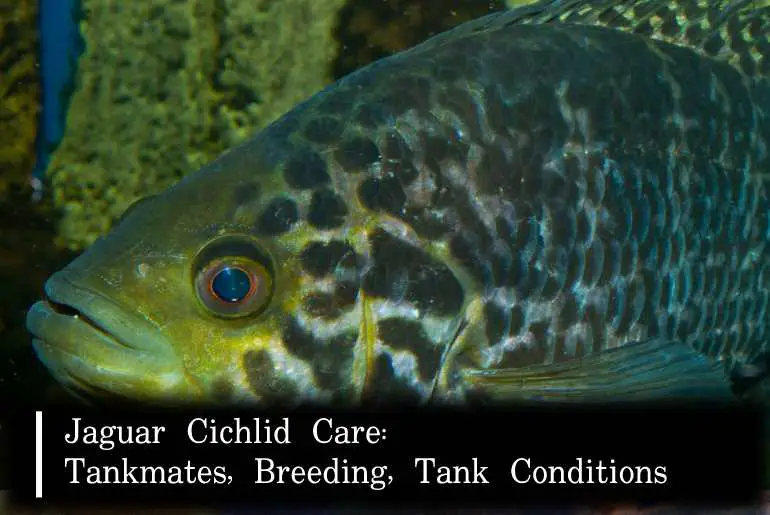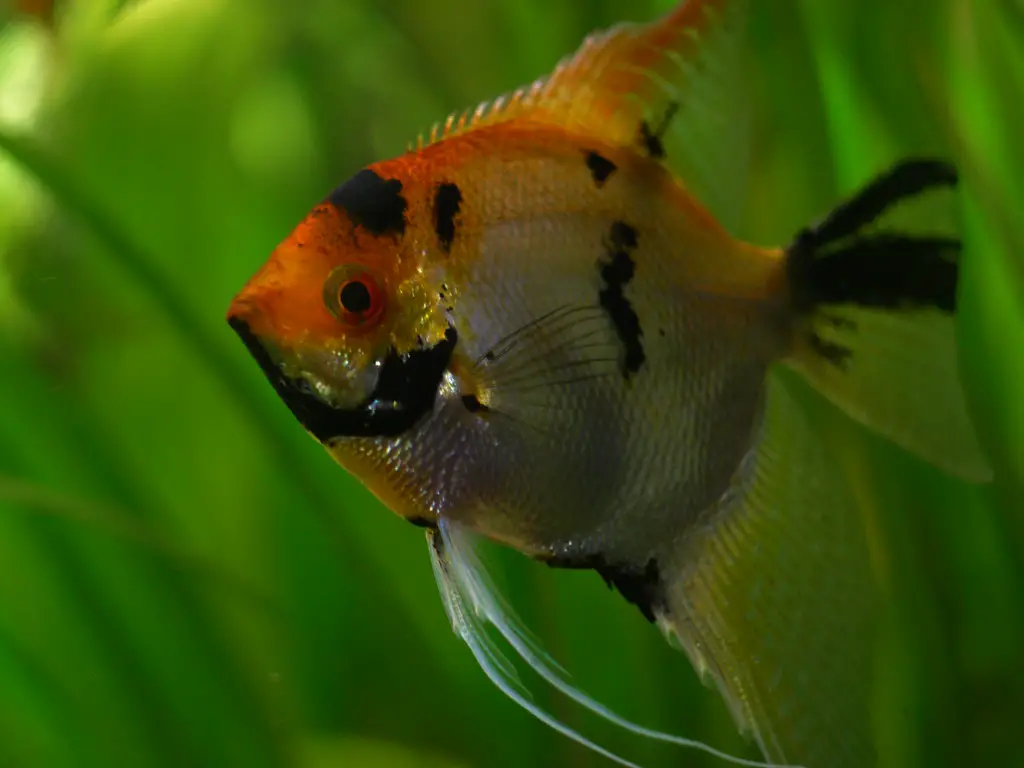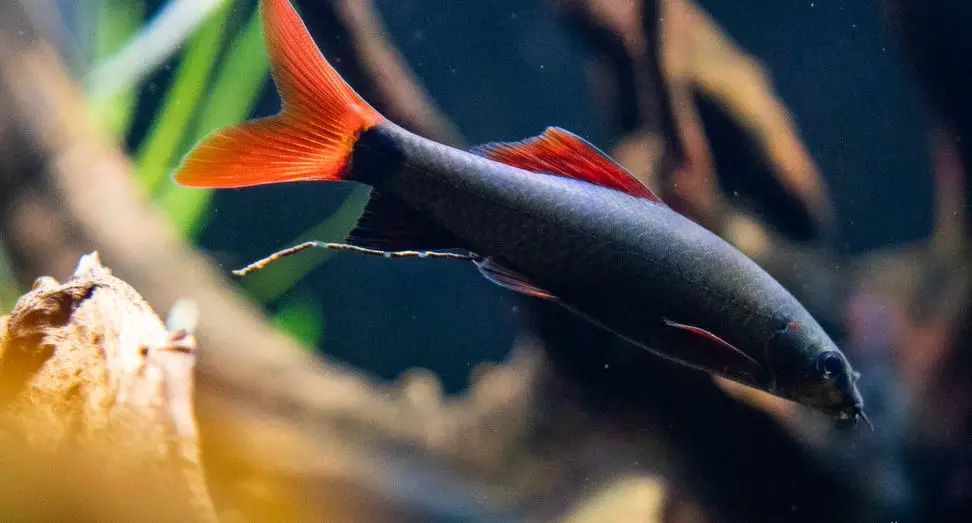Jaguar Cichlids, or Parachromis Panaguesis, is a large species of Cichlid. The Jaguar Cichlid has it all, from its spotted coloring that resembles a jaguar and its skill at hunting to its intimidating personality. Many aquarists are familiar with this popular freshwater species. But a lot of them are afraid to house this fearsome fish!
It is a fact that Jaguar Cichlids are unique and beautiful, but it is also a fact that Keeping jaguar Cichlids is not for everyone. Before housing the Jaguar Cichlid, many breeders will advise that you have some experience caring for fish, especially the Cichlid species. This is the reason we created this manual. You’ll discover all there is to know about taking care of Jaguar Cichlids and general information on the species that will help you become a more aware owner.
Read more to learn more about this fish and its maintenance, breeding, and feeding practices and to get the answers to your questions.
Origin
Jaguar Cichlids go by various names. These fish may also be referred to as Managuense Cichlids or Aztec Cichlids in addition to the name Jaguar Cichlid. Locals usually call them Guapote Tigre when they are discovered in their natural habitat.
Central America is the home of these Cichlids. The species was first found in Nicaragua’s Lake Managua. This fish may now be found in freshwater bodies in Honduras, Costa Rica, Mexico, Panama, and as far afield as Florida and Singapore, thanks to importation and the aquarium trade.
Lifespan
The typical lifespan of a Jaguar Cichlid is roughly 15 years! Therefore, if you’re considering adopting one for yourself, get ready for some commitment.
That is merely a rough average, though. With regular maintenance and ideal tank conditions, some fish keepers have been able to prolong the lifespan of their fish over the 15-year mark. We recommend all Jaguar Cichlid owners adopt this strategy, but it is going to take a lot of time and effort.
Appearance
The Jaguar Cichlid possesses many characteristics that improve its capabilities as a predator.
When viewed from the side, its body is flat and oval-shaped but from above, it is slim and sleek, enabling it to travel swiftly through the water. The hard spines that support the swept-back dorsal and anal fins shield them from other fish that are hungry predators.
The Jaguar Cichlid does not have the small, stubby fins that are common in many Cichlids. Both the dorsal and tail fins are very noticeable. The spines give them a slightly threatening appearance. Additionally, particularly in men, the anal fin is rather noticeable.
Last but not least, this fish has a broad mouth and pointed incisors on the bottom lip. The jaguar cichlid can devour huge prey thanks to its extendable jaw.
Jaguar Cichlids Change Color With Age
The ability of this fish to alter its appearance with age is one of its most fascinating features.
These fish have a light goldish-silver color when these cichlids are young. The fish’s back is covered with wide black bars.
Those black bands on your fish’s body will gradually change into dots as it ages. The fish’s recognizable jaguar color pattern is due to this. Not just that. Larger black splotches will appear after the black bands have vanished.
These black markings might often resemble enormous jaguar spots. Sometimes these fish mix with one another. In either case, a horizontal-shaped stripe that extends from its tail to its head is almost always formed by the bigger black dots.
The male and female Jaguar Cichlids differ in a few noticeable ways. Examining the fins is one of the simplest methods to distinguish between the two. Males have dorsal and anal fins that are expanded and come to a lovely tip. Males are often visibly bigger than females.
Difference Between Male And Female Jaguars
The male and female specimens differ in a few noticeable ways. Examining the fins is one of the simplest methods to distinguish between the two. Males have dorsal and anal fins that are expanded and come to a lovely tip. Males are often visibly bigger than females.
Size
Your jaguar cichlid will certainly grow to be quite large, which is common in many cichlid species. Jaguar Cichlid typically grows to adult lengths of 14 to 16 inches. These fish can grow to a maximum length of two feet (60 cm) in the wild, which is just a little bit shorter than this.
Behavior
The level of aggression of Jaguar Cichlids is categorized as aggressive fish because these cichlids may act aggressively toward both other fish in the aquarium and other members of their own species.
Even bonded couples occasionally act violently toward one another. We advise against keeping this species in a home aquarium unless you have some prior expertise in taking care of cichlids.
Cichlids can be aggressive and territorial. If you have many jaguar cichlids, be ready to put them in a tank big enough for each to have its own space.
Diet
A meal rich in protein is optimal for jaguar cichlids.
Maintain a consistent feeding schedule and eat only one meal each day. Feed your fish only what these fish can consume in a few minutes. Food that is left over in excess may rot and affect the water’s quality.
You may feed your jaguar cichlid any of the following fresh or frozen foods.
- Feeder fish
- Insects
- Worms (bloodworms or earthworms):
- Prawns
Tank Size
The size and age of the Jaguar Cichlid determine the ideal tank size. Since these fish may grow more than 16 inches in length, it’s essential to provide them with the room they require.
Juveniles may often thrive in a basic 30-gallon tank. They will, however, outgrow that very fast. A minimum tank capacity of 70 gallons is required if you intend to keep a single fully-grown Jaguar Cichlid.
A simple tank of this size has proved to be successful for many aquarists. More room is always better if your goal is to provide your fish with the best possible quality of life.
Water Parameters
It’s crucial to precisely replicate the Jaguar Cichlids’ native habitat while creating the ideal home for them. These fish originate from several Central American lakes and rivers. The water is usually quite warm and neutral.
The wonderful quality of Jaguar Cichlids is how flexible these fish are. Cichlids adapt to changes in parameters far more easily than other fish. These fish can survive in temperatures of up to 97 degrees!
However, it’s advisable to stay within a small range and, if at all possible, keep away from significant changes. Keep the temperature at a normal level since these fish tend to become more aggressive in warm temperatures.
Make sure you get these water parameters right.
- Water temperature should be between 73°F and 82°F.
- The PH of the Jaguar tank ranges from 7.0 to 8.7 (around 7.7 is ideal).
- The hardness of the water should be around 10 to 15 dGH.
Decorations
Fill the tank’s base with dark sand or gravel. Again, bear in mind that jaguar cichlids are energetic diggers that enjoy rearranging their environment, so think about using floating plants or ones you can place at the bottom. The same is true with other ornaments.
The jaguar cichlid likes to have a safe spot to hide while having a tough demeanor. Think about putting in caves or rocks at the tank’s perimeter while leaving a large open swimming space in the middle.
I have written a detailed article about how to decorate your tank as a beginner. Find out more on this topic here!
Equipment
Choose a durable filter since jaguar cichlids create a lot of waste.
Canister filters will take care of the waste and lessen the possibility of rising nitrate and ammonia levels. Ensure that a strong current can be produced by the filter.
Eheim Classic External Canister Filter worked best for me. Thus, you can check it out for your Jaguar cichlid as well. It is easy to work with and has the correct current flowing in the tank.
There are no special lighting needs for this fish. Any in-tank floating plants will contribute to creating some shade.
Add a heater to maintain a pleasant and constant temperature.
Tank Mates
It all comes down to understanding each Jaguar Cichlid’s attitude and natural compatibility when choosing tank mates.
A second Jaguar Cichlid is the ideal fish to keep with a Jaguar Cichlid. Bonded pairs can coexist successfully and have fulfilling lives. Buying a pair that has already formed a relationship is the simplest method to achieve this. Alternately, you can temporarily combine some young males and females until those bonds develop.
Other fish might be kept in the same tank. However, you must exercise extreme caution. Any fish smaller than the Managuense Cichlid should not be added. Otherwise, it will soon be eaten.
Here are some species that some fishkeepers have seen survive with Jaguar Cichlids.
- Convict Cichlid
- Green Terror Cichlid
- Flowerhorn Cichlid
- Red Devil Cichlid
- Oscar Fish
Breeding
As we have already established, Jaguar Cichlids thrive in bonded pairs. It is easier if you buy the pair already bonded. Or you may buy juvenile fish and let them couple up naturally.
In a communal tank, a bonded couple that is ready to breed could act aggressively against the other tank members.
The female’s swelling with eggs may be the only indication that the fish are ready to reproduce if they are the only ones in the tank.
By providing the bonded couple with a healthy diet, you can promote reproduction. Change the breeding tank’s water by half twice a week, and elevate the temperature to the upper end of their tolerance range (around 82 degrees Fahrenheit, 28 degrees C).
Spawning And Fry Care
The female jaguar cichlid will lay her eggs either within a cave or on a flat rock. Do not be surprised if you see more than 2000 eggs!
The male will stay to guard the eggs after fertilization. Make sure your bonded couple is in a separate breeding tank because the male may be rather aggressive at this time. Plus, you also run the danger of hurting your other fish.
The eggs can hatch anywhere between five and seven days. The male and female both keep watch over the eggs at this period and even defend the fry.
It takes the fry roughly a week to learn to swim freely. When this happens, take the parents out and start feeding young brine shrimp to the fry. Replace 20% of the water every other day.
Diseases
Jaguar Cichlids are hardy, but these fish are not immune to health issues. Fortunately, there are no problems specific to this species that you need to be concerned about. With the correct water conditions, they are resilient fish that will remain healthy.
You simply need to be concerned about the typical illnesses that affect all freshwater fish. This includes infections and Ich.
Ich is a particularly terrible condition that is frequently caused because of stress. The fish may develop white spots all over its body as a result. It can result in death if not treated. Additionally, it is quite infectious.
The best strategy to prevent Ich is to monitor water quality. Regularly take measurements and modify them as necessary.
Frequently Asked Questions
What Do Jaguar Cichlids Eat?
The jaguar cichlid loves eating tadpoles, earthworms, and crickets. Remember to only feed them once each day because they have the habit of overeating. Given how much food these fish require to grow to adult size, frozen food is another excellent dietary staple to offer. However, it may get pricey.
Are Jaguar Cichlids Good Companions For Oscars?
This fish could be a beneficial companion for the Oscar fish. But be aware that you need have prior experience keeping hostile fish together if you want to maintain these fish as companions. The jaguar cichlid is more of a semi-aggressive fish than an aggressive one.
Can Two Male Jaguar Cichlids Live Together?
Jaguar cichlids are aggressive, even toward members of their own species, but with the correct care, a pair may often be maintained. A female jaguar Cichlid is one of the best tank mates for males.
Conclusion
I believe you are well informed about the Jaguar Cichlid now. It is up to you to decide if you want to house one.
We recommend you try raising one if you are a little more experienced and prepared for the challenge. We’ve always said that keeping fish that need more maintenance is not only more rewarding but also the best method to advance your aquarist abilities.
The Jaguar Cichlid is a beautiful species that is popular for its fierce nature. It is a truly amazing addition to your tank. Good luck on your fishkeeping journey!






